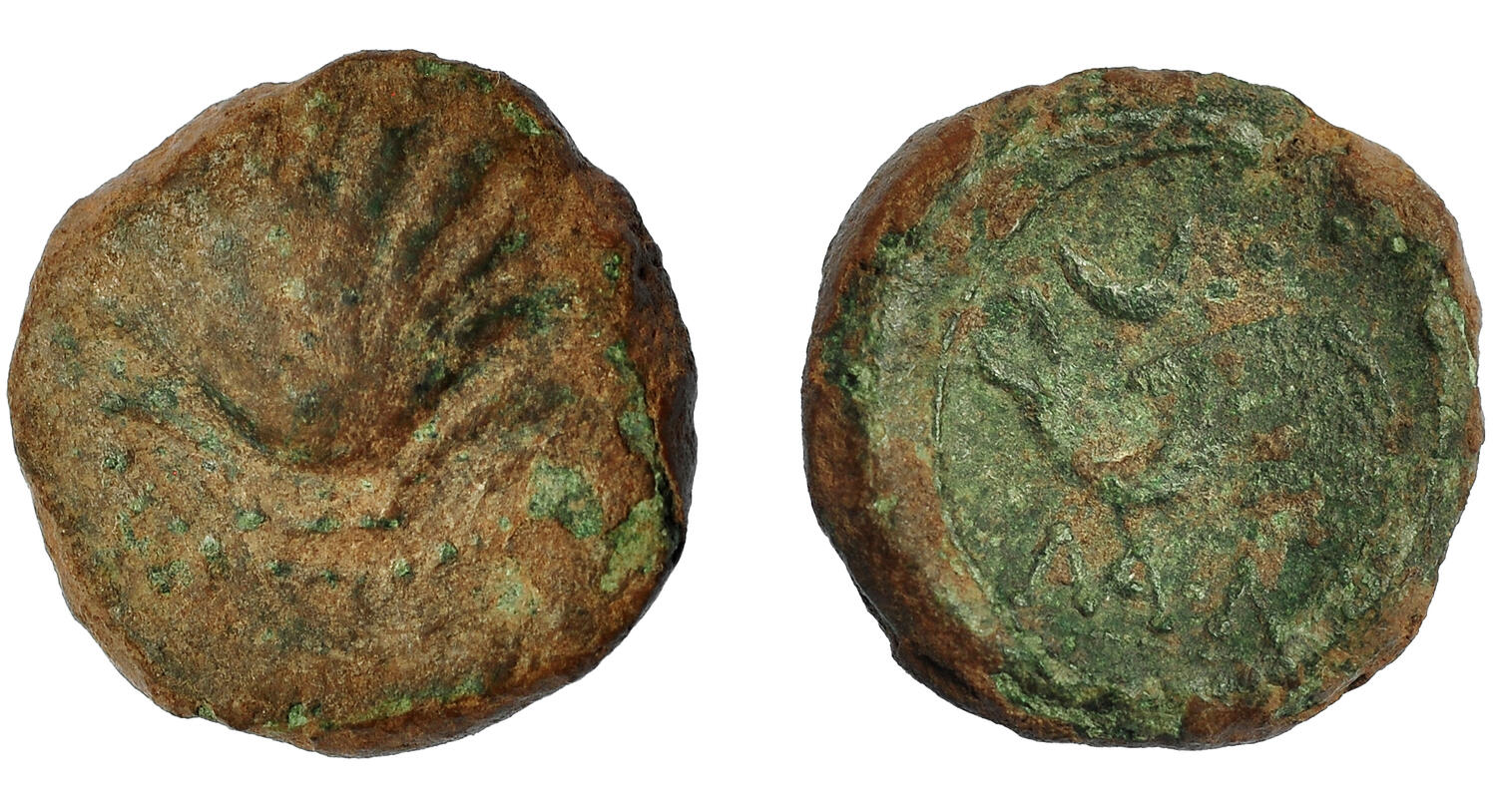Arse-Saguntum (Roman Republic), bronze, quadrantes, ca 3.5g (pecten/dolphin) (72-30 BCE)
From SILVER
(Redirected from S 1679 - Arse-Saguntum, bronze, quadrantes (72-30 BCE))
72 BCE - 30 BCE Bronze
Description
| ObverseInscription or printing placed on the obverse.: | Scallop shell |
| ReverseInscription or printing placed on the reverse.: | MA MB (below) (Latin).Dauphin right, above crescent and 3 dots |
Mint and issuing power
| MintIdentifies the place of manufacture or issue of a numismatic object.: | Arse-Saguntum | Ancient regionAncient region.: | Hispania Citerior | Modern countryModern country: Spain | AuthorityIdentifies the issuing power. The authority can be "pretended" when the name or the portrait of X is on the coin but he/she was not the issuing power. It can also be "uncertain" when there is no mention of X on the coin but he/she was the issuing power according to the historical sources: | Roman Republic |
Chronology
| FromIdentifies the initial date in a range assigned in a numismatic context. | 72 BCE | toIdentifies the final date in a range assigned in a numismatic context.. | 30 BCE | PeriodTime period of the numismatic object.: Hellenistic 323-30 BC |
Physical description
| MetalThe physical material (usually metal) from which an object is made.: | Bronze |
Median weightMedian of the weights of numismatic objects (in grams). in grams | 3.50 | DenominationTerm indicating the value of a numismatic object. Examples: tetradrachm, chalkous, denarius.: | quadrans |
StandardStandard.: |
Image

S 1679 - Arse-Saguntum, bronze, quadrantes (72-30 BCE).jpg [1]
References
| Die study referencePublication of the study: | Ripollès - Llorens 20021Ripollès - Llorens 2002, p. 472-475, n° 398-406: O208-212/ R284-291 (Period IV) | ||
| Coin series referenceReference to coin series study: | ACIP2ACIP, n° 2017 | ||
| Coin series web referenceCoin series web references: | |||
Obverse dies distribution
| FrequencyFrequency of specimen in distribution. ᵖ | Number of obversesNumber of obverse dies. ᵖ (o) | % (o) | Number of coinsNumber of coins. (n) | % (n) | Die nameName(s) of the die(s). |
| 2 | 1 | 20 | 2 | 6.25 | 210 |
| 3 | 1 | 20 | 3 | 9.38 | 209 |
| 6 | 1 | 20 | 6 | 18.75 | 212 |
| 9 | 1 | 20 | 9 | 28.13 | 208 |
| 12 | 1 | 20 | 12 | 37.5 | 211 |
| Total | 5 of 5 | 100 | 32 of 32 | 100.01 |
Reverse dies distribution
no distribution is available
Quantification
| Number of obversesNumber of obverse dies. ᵖ (o) | 5 | Number of singletons (o1)The number of singleton coins. ᵖ | 0 |
| Number of reverse diesNumber of reverse dies. (r) | 6 | Number of coinsNumber of coins. (n) | 32 |
| Coins per obverse dieNumber of coins per obverse die. (n/o) | 6.4 | Coins per reverse dieNumber of coins per reverse die. (n/r) | 5.33 |
| Reverse per obverse ratioRatio of obverse dies divided by reverse dies. (r/o) | 1.2 | Percentage of singletons (o1)number of coins (n) divided by the number of singletons (o1) ᵖ | 0 % |
| Original number of dies (O) (Carter 1983 formula)The estimation of the number of coins according to Carter 1983 ᵖ | 5.33 | Coins struck if 20,000 as average productivity per dieCoins made if the average productivity for obverses (according to Carter) is 20,000. ᵖ | 106,600 |
| Original number of dies (O) (Esty 2011 formula)The estimation of the number of coins according to the singleton formula in Esty 2011 ᵖ (O) | 5.93 | Survival rate if 20,000 as average productivity per dieSurvival rate if average productivity is 20,000. ᵖ | 0.00030 |
| Coverage (o = % of O) (Esty 1984 formula)Esty 1984 - coverage (% of O) ᵖ (o = % of O) | 100% | Die productivity if survival rate 1/2,000Average productivity if survival rate is 1/2,000. ᵖ | 12,007.5 |
| Weight of silver (in kg) if 20,000 coins per die (O = Carter formula)Carter 1983 * Median weight * 20000 (*10 if gold or electrum) ᵖ | n.a. | Die productivity if survival rate 1/5,000Average productivity if survival rate is 1/5,000. ᵖ | 30,018.76 |
Remarks
Most likely one single workstation Likely military See chart p. 205